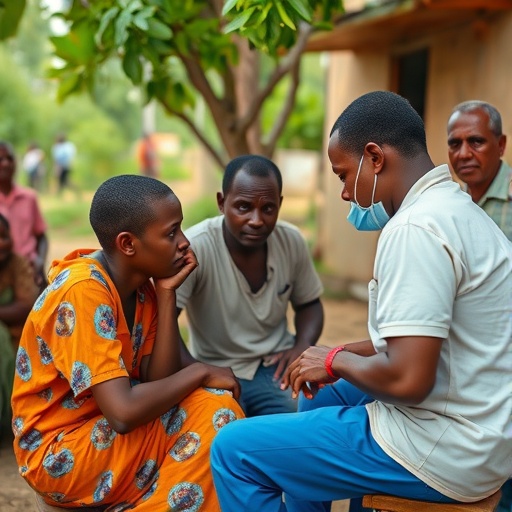Spring Health Wins Stevie® Award for Technical Innovation – PR Newswire

Executive Summary: Spring Health’s Technological Innovation Award and Alignment with Sustainable Development Goals
Spring Health has been awarded a Bronze in the 2025 Stevie® Awards for Technical Innovation of the Year. This recognition, selected from over 1,500 global entries, highlights the company’s significant contributions to advancing mental healthcare through data-driven technology. The company’s innovative approach directly supports several United Nations Sustainable Development Goals (SDGs), particularly SDG 3 (Good Health and Well-being), SDG 8 (Decent Work and Economic Growth), and SDG 9 (Industry, Innovation, and Infrastructure). By leveraging technology to improve mental health outcomes and reduce employer healthcare costs, Spring Health demonstrates a strong commitment to creating a sustainable and healthy future for the global workforce.
Advancing SDG 3: Good Health and Well-being through Precision-Based Care
Spring Health’s core mission is fundamentally aligned with SDG 3, which aims to ensure healthy lives and promote well-being for all at all ages. The company’s platform is a key tool in achieving Target 3.4, which focuses on promoting mental health and well-being.
Key Technological Contributions:
- Precision Matching Technology: The platform utilizes machine learning to accurately and rapidly match individuals to the most appropriate form of care, whether it be digital tools, coaching, therapy, or medication. This accelerates access to effective treatment, directly improving health outcomes.
- The Atlas Platform: This innovation provides employers with real-time, actionable insights into the mental health of their workforce. By turning complex behavioral health data into clear strategies, Atlas empowers organizations to proactively enhance care, thereby fostering a healthier work environment.
- Specialized Care: The platform addresses critical gaps in workplace mental health by providing specialized care for high-risk individuals, ensuring that vulnerable populations receive the targeted support necessary for their well-being.
Fostering SDG 8: Decent Work and Economic Growth
By integrating mental health solutions into the workplace, Spring Health makes a direct contribution to SDG 8, which promotes sustained, inclusive, and sustainable economic growth, full and productive employment, and decent work for all.
Impact on the Workplace:
- Enhanced Productivity and Safety: A mentally healthy workforce is a more productive and safer one. By providing accessible mental health support, Spring Health helps create secure working environments as outlined in Target 8.8.
- Sustainable Economic Practices: The platform is certified for delivering net savings to customers. By reducing employer healthcare costs, it enables businesses to invest resources more sustainably, contributing to long-term economic growth.
- Demonstrable ROI: The ability to show tangible outcomes and return on investment (ROI) encourages more employers to adopt comprehensive mental health strategies, scaling the positive impact on the global workforce.
Driving SDG 9: Industry, Innovation, and Infrastructure
The Stevie® Award for Technical Innovation explicitly recognizes Spring Health’s role in advancing SDG 9, which seeks to build resilient infrastructure, promote inclusive and sustainable industrialization, and foster innovation.
Innovation in Healthcare Infrastructure:
- Application of Advanced Technology: As noted by an award judge, Spring Health’s primary innovation lies in the effective application of existing technologies like AI and machine learning to solve complex healthcare challenges at scale. This aligns with Target 9.5, which encourages upgrading the technological capabilities of industrial sectors.
- Data-Backed Decision Making: The platform empowers employers to move beyond reactive measures and make strategic, data-backed decisions about employee well-being. This represents a significant upgrade to traditional human resources and corporate health infrastructure.
Supporting SDG 10 and SDG 17 through Partnerships and Accessibility
Spring Health’s model also supports SDG 10 (Reduced Inequalities) and SDG 17 (Partnerships for the Goals) by expanding access to care through strategic collaborations.
Expanding Impact Through Collaboration:
- Reducing Health Inequalities (SDG 10): By delivering mental health solutions through employers and health plans, Spring Health helps reduce inequalities in access to critical health services for over 20 million people worldwide.
- Multi-Stakeholder Partnerships (SDG 17): The company’s success is built on effective public-private and civil society partnerships. Its collaboration with leading employers such as Microsoft, Target, and The Coca-Cola Company, as well as health plans like Highmark, exemplifies the partnership model required to achieve the SDGs at scale.
1. Which SDGs are addressed or connected to the issues highlighted in the article?
SDG 3: Good Health and Well-being
- The article’s central theme is the improvement of mental health through Spring Health’s platform. This directly aligns with SDG 3, which aims to ensure healthy lives and promote well-being for all at all ages. The company is described as a “complete global mental health solution” that works to “improve mental health outcomes.”
SDG 8: Decent Work and Economic Growth
- The service is specifically designed for employers to support their workforce. By providing tools to manage “workforce mental health,” Spring Health contributes to creating healthier and more supportive work environments. This connects to SDG 8’s goal of promoting “safe and secure working environments for all workers.”
SDG 9: Industry, Innovation, and Infrastructure
- The article repeatedly emphasizes the company’s use of “data-driven technology,” “machine learning,” and “responsible AI” to solve healthcare challenges. Being recognized with a “Stevie® Award for Technical Innovation” highlights its contribution to technological advancement and innovation within the healthcare industry, which is a core component of SDG 9.
SDG 17: Partnerships for the Goals
- Spring Health’s business model is built on partnerships with other private sector entities, including “leading employers, health plans and channel partners” like Microsoft, Target, and Pfizer. This collaborative approach to achieving health and well-being goals reflects the spirit of SDG 17, which encourages partnerships to achieve sustainable development.
2. What specific targets under those SDGs can be identified based on the article’s content?
SDG 3: Good Health and Well-being
- Target 3.4: By 2030, reduce by one-third premature mortality from non-communicable diseases through prevention and treatment and promote mental health and well-being. The article directly addresses the second half of this target by describing Spring Health’s mission to “promote mental health and well-being” and provide “specialized care for high-risk individuals.”
- Target 3.8: Achieve universal health coverage, including financial risk protection, access to quality essential health-care services… The article mentions that Spring Health provides access to care for “more than 20 million people worldwide” through employers, thereby increasing access to quality mental healthcare. It also notes the platform helps “reduce employer healthcare costs,” which relates to financial risk protection.
SDG 8: Decent Work and Economic Growth
- Target 8.8: Protect labour rights and promote safe and secure working environments for all workers… The article describes how the Atlas platform gives employers “real-time visibility into workforce mental health,” enabling them to “enhance care strategies.” This directly contributes to creating a psychologically safer and more secure working environment.
SDG 9: Industry, Innovation, and Infrastructure
- Target 9.5: Enhance scientific research, upgrade the technological capabilities of industrial sectors in all countries… and encourage innovation. Spring Health’s recognition for “Technical Innovation of the Year” and its use of a “precision-based platform, which uses machine learning” are clear examples of upgrading technological capabilities and fostering innovation in the healthcare sector.
SDG 17: Partnerships for the Goals
- Target 17.17: Encourage and promote effective public, public-private and civil society partnerships… The article highlights Spring Health’s model of partnering with major corporations (“The Coca Cola Company, BlackRock, Microsoft, Pfizer, and Wawa”) to deliver its mental health solution, demonstrating a private-private partnership model to achieve health outcomes.
3. Are there any indicators mentioned or implied in the article that can be used to measure progress towards the identified targets?
Indicators for SDG 3 Targets
- Improved clinical outcomes: The article states the platform drives “better clinical outcomes for individuals” and delivers “faster, more effective results,” which can be measured to track progress towards Target 3.4.
- Reduction in healthcare costs: The platform is certified for “demonstrating net savings for customers” and its ability to “reduce employer healthcare costs.” This serves as a direct financial indicator related to the efficiency and financial risk protection aspect of Target 3.8.
- Access to care: The statement that “more than 20 million people worldwide have access to Spring Health” is a quantifiable indicator of the reach of their healthcare services, relevant to Target 3.8.
Indicators for SDG 8 Target
- Actionable insights for HR teams: A judge’s comment that the platform “stands out by turning complex behavioral health data into actionable insights, enabling HR teams to enhance care strategies” implies that the use and impact of these insights can be measured as an indicator of a safer work environment under Target 8.8.
Indicators for SDG 9 Target
- Application of advanced technology: The explicit mention of using “machine learning,” “data-driven technology,” and “responsible AI” serves as an indicator of technological upgrading as per Target 9.5.
- Industry recognition for innovation: Being named a “Bronze winner in the 2025 Stevie® Awards for Technical Innovation of the Year” is a formal, external indicator of successful innovation.
Indicators for SDG 17 Target
- Number and quality of partnerships: The list of “trusted by leading employers, health plans and channel partners” (e.g., Microsoft, Target, Pfizer) serves as an indicator of the scale and effectiveness of the private-private partnerships described in Target 17.17.
4. SDGs, Targets and Indicators Table
| SDGs | Targets | Indicators Identified in the Article |
|---|---|---|
| SDG 3: Good Health and Well-being | 3.4: Promote mental health and well-being.
3.8: Achieve access to quality essential health-care services and financial risk protection. |
|
| SDG 8: Decent Work and Economic Growth | 8.8: Promote safe and secure working environments for all workers. |
|
| SDG 9: Industry, Innovation, and Infrastructure | 9.5: Enhance research and upgrade technological capabilities, encouraging innovation. |
|
| SDG 17: Partnerships for the Goals | 17.17: Encourage and promote effective public-private and civil society partnerships. |
|
Source: prnewswire.com

What is Your Reaction?
 Like
0
Like
0
 Dislike
0
Dislike
0
 Love
0
Love
0
 Funny
0
Funny
0
 Angry
0
Angry
0
 Sad
0
Sad
0
 Wow
0
Wow
0

























_1.png?#)























































